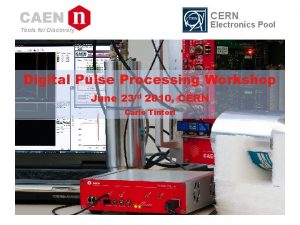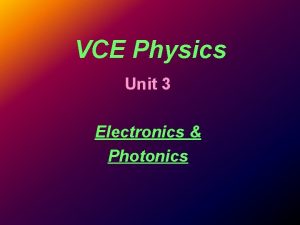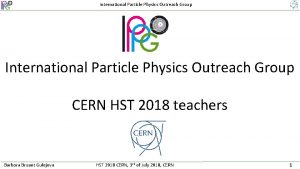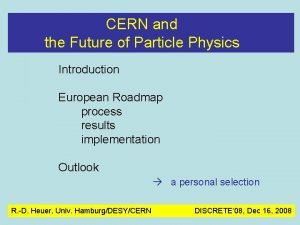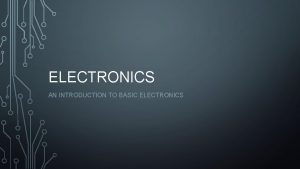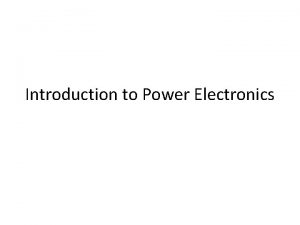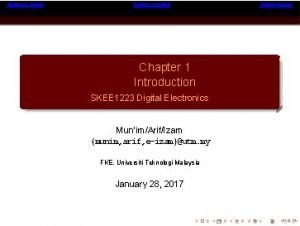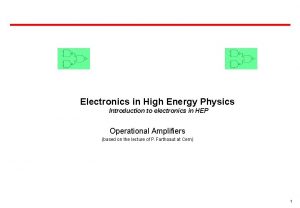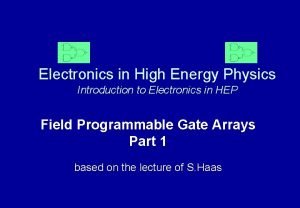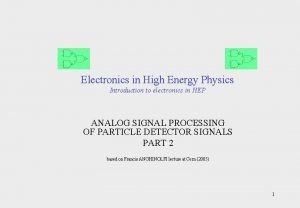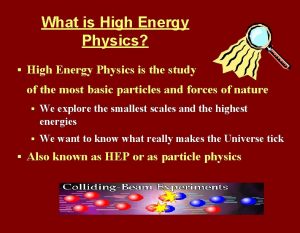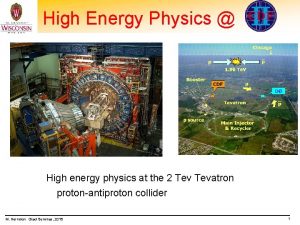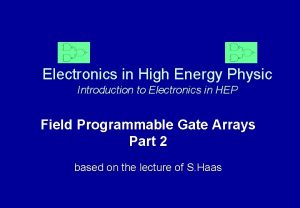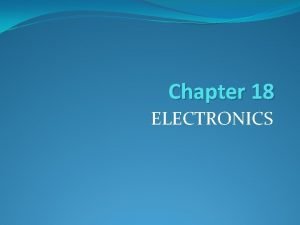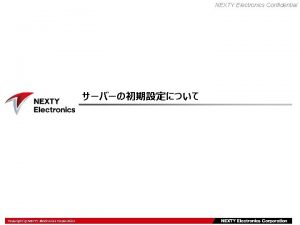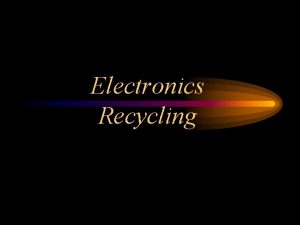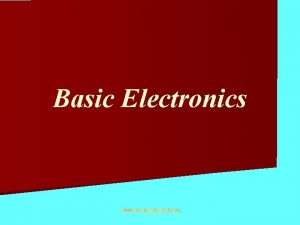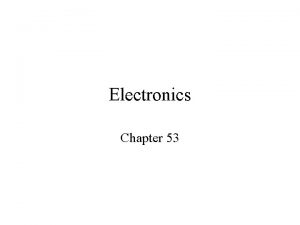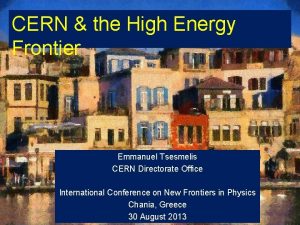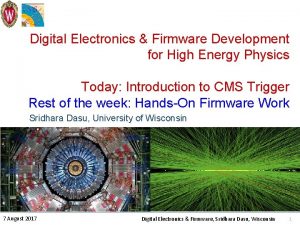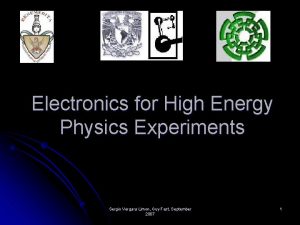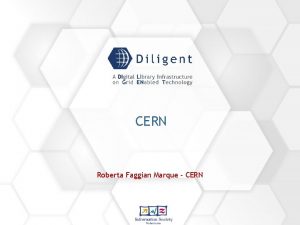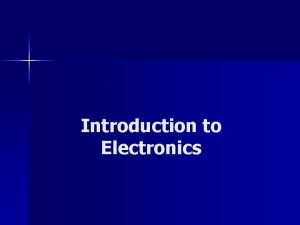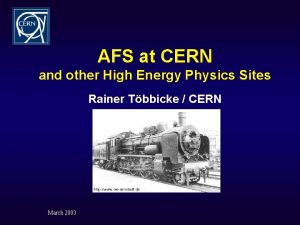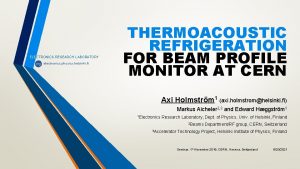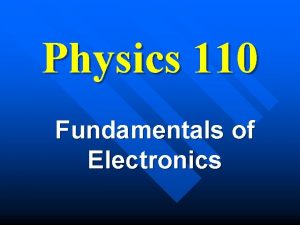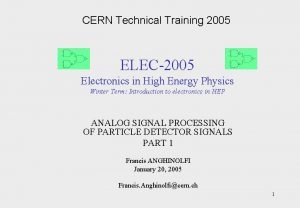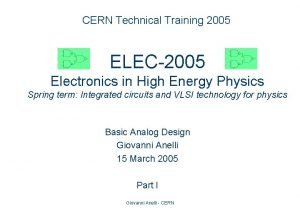Introduction to Electronics for High Energy Physics CERN























- Slides: 23

Introduction to Electronics for High Energy Physics CERN Summer school 2003 C. de LA TAILLE LAL Orsay 9 -11 july 2003 C. de La Taille@lal. in 2 p 3. fr Electronics CERN Summer School 2003 1

Outline n Course 1 : The art of electronics : is there something beyond Ohm’s law ? n Course 2 : Learning to decipher a schematic n Course 3 : Electronics in high energy physics 9 -11 july 2003 C. de La Taille Electronics CERN Summer School 2003 2

Introduction n Speak “electronician” in just 3 lessons… “Did you cascode your charge preamp to increase your open loop gain ? ” n “Did you find an FPGA with LVDS I/Os for your digital filter ? ” n A lot of vocabulary (and abreviations…) to get used to, but : n n Little prerequisite knowledge required : Ohm’s law : U = Z I n Some basics of Fourier (or Laplace) transforms cannot hurt for signal theory n n Many more details are given in the transparencies -> don’t be scared ! 9 -11 july 2003 C. de La Taille Electronics CERN Summer School 2003 3

Electronics in experiments n A lot of electronics in the experiments… Readout electronics : amplification, filtering… : Analog electronics (A, V, C) n Processing & Trigger electronics : Digital electronics (bits) [see lecture of Cittolin] n The performance of electronics often impacts on the detectors n 9 -11 july 2003 C. de La Taille Electronics CERN Summer School 2003 4

Overview of readout electronics n Most front-ends follow a similar architecture f. C Detector V Preamp V Shaper Analog memory V ADC bits FIFO DSP… n Very small signals (f. C) -> need amplification n Measurement of amplitude and/or time (ADCs, discris, TDCs) n Several thousands to millions of channels 9 -11 july 2003 C. de La Taille Electronics CERN Summer School 2003 5

Readout electronics : requirements Low noise High speed Low power Large dynamic range High reliability Radiation hardness Low cost ! Low material (and even less) 9 -11 july 2003 C. de La Taille Electronics CERN Summer School 2003 6

The foundations of electronics n Voltage generators or source Ideal source : constant voltage, independent of current (or load) n In reality : non-zero source impedance RS n V RS → 0 n Current generators Ideal source : constant current, independent of voltage (or load) n In reality : finite output source impedance RS n RS → ∞ i n Ohms’ law Z = R, 1/jωC, jωL n Notice the sign convention n 9 -11 july 2003 C. de La Taille i V Z Electronics CERN Summer School 2003 7

Frequency domain & time domain n Frequency domain : n V(ω, t) = A sin (ωt + φ) • Described by amplitude and phase (A, φ) n Transfer function : H(ω) [or H(s)] n = The ratio of output signal to input signal in the frequency domain assuming linear electronics n Vout(ω) = H(ω) Vin(ω) vin(ω) H(ω) vout(ω) h(t) vout(t) F -1 n Time domain n Impulse response : h(t) n = the output signal for an impulse (delta) input in the time domain The output signal for any input signal vin(t) is obtained by convolution * : n Vout(t) = vin(t) * h(t) = ∫ vin(u) * h(t-u) du vin(t) n n Correspondance through Fourier transforms n X(ω) = F { x(t) } = ∫ x(t) exp(jωt)dt n a few useful Fourier transforms in appendix below 9 -11 july 2003 C. de La Taille Electronics CERN Summer School 2003 8

Appendix 1 : a few useful Fourier Transforms n n n H(ω) = 1 <-> H(ω) = 1/jω H(ω) = 1/(1+jωT) H(ω) = 1/jω (1+jωT) H(ω) = 1/(1+jωT)n … 9 -11 july 2003 h(t) = δ(t) (impulse) h(t) = S(t) = (step) h(t) = exp(-t/T) (low pass filter, exponential) h(t) = 1 - exp(-t/T) h(t) = 1/n! (t/T)n-1 exp(-t/T) C. de La Taille Electronics CERN Summer School 2003 9

Using Ohm’s law n Example of photodiode readout Used in high speed optical links n Signal : ~ 10 µA when illuminated n Modelisation : n volts • Ideal current source Iin • pure capacitance Cd light n Simple I to V converter : R ! n R = 100 kΩ gives 1 V output for 10 µA 10 Gb/s optical receiver (Orx) n Speed ? Transfer function H(ω) = vout/iin n H has the dimension of Ω and is often called « transimpedance » and even more Vout n often (improperly) « gain » I in Cd 100 K H(ω) = R/(1 + jω RCd) n -1/j. RCd is called a « pole » in the transfer function n 9 -11 july 2003 C. de La Taille Electronics CERN Summer School 2003 10

Frequency response n Bode plot Magnitude (d. B) = 20 log |H(jw)| n -3 d. B bandwidth : f-3 d. B = 1/2πRC n 100 d. BΩ • R=105Ω, C=10 p. F => f-3 d. B=160 k. Hz • At f-3 d. B the signal is attenuated by 3 d. B = √ 2, the phase is -45° n 80 d. BΩ Above f-3 d. B , gain rolls-off at -20 d. B/decade (or -6 d. B/octave) Phase 9 -11 july 2003 C. de La Taille Electronics CERN Summer School 2003 11

Time response 10 Gb/s eye diagram ps/div) Impulse(10 response n Impulse response n h(t) = F -1 { R/(1+jωRC) } = R/ τ exp(-t/τ) n τ (tau) = RC = 1 µs : time constant n Step response : rising exponential n H(t) = F -1 { 1/jω R/(1+jωRC) } = R [ 1 - exp(-t/ τ) ] n Rise time : t 10 -90% = 2. 2 τ n « eye diagramm » n Speed : ~ 10 µs = 100 kb/s ! n Still 5 orders ofmagnitude away from a 10 Gb/s link ! 9 -11 july 2003 C. de La Taille pulse response tr 10 -90% Electronics CERN Summer School 2003 12

Current preamplifiers in theory n Improve with an opamp Vout = G(vin+- vin-) n G >> 1 : « open loop gain » n Vin+ = 0 ; iin- = 0 n n Transimpedance configuration Rf between input and output ( « shunt-shunt feedeback » ) -> « current preamp » (PAI) n Transfer function : n Current preamplifier architecture • Vout - vin = - Rf if • Vin = (iin - if)/ jω Cd = - vout/G vout/iin = - Rf /(1 + jω Rf. Cd/G) n Bandwidth improvement by G >>1 n Example with LM 741, (G 0=2 105) => BW = 3. 2 THz ! 9 -11 july 2003 C. de La Taille Looks great ! Electronics CERN Summer School 2003 13

Current preamp in practice n With an old LM 741 n Oscillations : ω0 = 500 k. Hz 9 -11 july 2003 C. de La Taille Electronics CERN Summer School 2003 14

Current preamp in practice n Trying a more modern opamp… (OP 620 GBW=300 MHz) n More (but faster) oscillations 9 -11 july 2003 C. de La Taille Electronics CERN Summer School 2003 15

Stability in current preamps Open loop frequency response of OP 620 n What happens ? Opamp open loop gain varies with frequency n G(ω) = G 0/(1 + j ω/ω0) n • G 0 : low frequency gain • ω0 : dominant pole • 90° phase shift above ω0 n 90° Phase shift in opamp + 90° phase shift on detector capacitance = 180° => oscillations frequency response of 2 nd order n Also with the maths : H(jω) = -Rf / (1 + jω Rf. Cd/G(ω)) - Rf / [1 + jω Rf. Cd(1/G 0 + jω/G 0 w 0)] - Rf / (1 + jω Rf. Cd/G 0 - ω2 Rf. Cd /G 0 w 0) n 2 nd order system n 9 -11 july 2003 C. de La Taille = = Electronics CERN Summer School 2003 16

Current preamp seen from the input Input impedance of PAI n Input impedance Zin = vin/iin = Rf/(G+1) -> small n Low input impedance = « virtual ground » n Current sensitive input n n Inductive behaviour With G(jω) = G 0/(1 + j ω/ω0) n Zin = Rf/ G 0 + j ω Rf/G 0ω0 n Virtual inductance : Leq = Rf/G 0ω0 n • Ex : LM 741 (G 0ω0=107) : Leq = 10 m. H • Ex : OP 620 (G 0ω0=109) : L = 100 µH n RLC circuit with capacitive detector Resonant frequency : fres = 1/2π √Leq. Cd n Quality factor : Q = R / √Leq/Cd n Q > 1/2 -> ringing • Ex : LM 741 : Q=105 √ 10 -2/10 -11 = 3 • Ex : OP 620 : Q=105 √ 10 -4/10 -11 = 31 ! n 9 -11 july 2003 C. de La Taille Cd 10 p. F Electronics CERN Summer School 2003 Rf 100 kΩ Equivalent circuit on the input Leq 100µH 17

Stabilisying the current preamp n Damping the oscillations: Need a resistor such as Q=1/2 n R = 0. 5 √Cd/Leq -> 1. 5 k n Resistor on the input : OK but noisy -> Virtual resistor : n n Capacitance in feedback : Cf n Resistive input impedance n Req = 1/ G 0ω0 Cf • Virtual resistor (noiseless) Q = 1/Cf √(Cd/Rf G 0ω0) n Q=1/2 => Cf=2 √(Cd/Rf G 0ω0) n Example : n • LM 741 (G 0ω0=107) : Cf=10 p. F • OP 620 (G 0ω0=109) : Cf=0. 5 p. F Cf n Speed : ~ 200 ns = 5 Mb/S n Only 3 more orders of magnitude to gain for the 10 Gb/s link ! 9 -11 july 2003 C. de La Taille Electronics CERN Summer School 2003 18

Charge preamps (1) n Capacitive feedback Transimpedance configuration n Similar to current preamp : Rf -> Cf n Vout(ω)/iin(ω) = - Zf = - 1/jω Cf n Integrator : vout(t) = -1/Cf ∫ iin(t)dt n vout(t) = - Q/Cf Charge preamplifier architecture n Charge sensitive preamplifier (PAC) n Output proportionnal to the incoming charge n « Gain » : 1/Cf n Cf = 1 p. F -> 1 m. V/f. C n Transforms a short pulse into a long one n The front-end of 90% of particle physics detectors 9 -11 july 2003 C. de La Taille Electronics CERN Summer School 2003 19

Charge preamps (2) n Input impedance of a PAC Zin = 1/jω G 0 Cf + 1/ G 0ω0 Cf n Low resistive input impedance n n Rin = 1/ G 0ω0 Cf G 0ω0 is given by the preamp design n Determines the risetime at the output : Req. Cd n Good stability (…!) n • Low sensitivity to detector capacitance • Small crosstalk 9 -11 july 2003 C. de La Taille Electronics CERN Summer School 2003 20

Charge preamp example n Monolithic circuit Input Output Cf 9 -11 july 2003 C. de La Taille Electronics CERN Summer School 2003 21

Charge preamps in practice n D 0 Lar calorimeter charge preamplifer Input Z 0 Output preamp driver Zf FET 9 -11 july 2003 2” C. de La Taille Electronics CERN Summer School 2003 22

10 Gb/s transimpedance amplifier n « Simple architecture » 9 -11 july 2003 C. de La Taille Electronics CERN Summer School 2003 23
 Cern electronics pool
Cern electronics pool Current divider formula
Current divider formula Cern particle physics
Cern particle physics Cern particle physics
Cern particle physics Introduction to basic electronics
Introduction to basic electronics Power electronics definition
Power electronics definition Vhmax
Vhmax Energy energy transfer and general energy analysis
Energy energy transfer and general energy analysis Energy energy transfer and general energy analysis
Energy energy transfer and general energy analysis Cern hssip
Cern hssip Cern high school internship
Cern high school internship Modern physics vs classical physics
Modern physics vs classical physics University physics with modern physics fifteenth edition
University physics with modern physics fifteenth edition Physics ia ib examples
Physics ia ib examples Fspos
Fspos Typiska drag för en novell
Typiska drag för en novell Nationell inriktning för artificiell intelligens
Nationell inriktning för artificiell intelligens Ekologiskt fotavtryck
Ekologiskt fotavtryck Shingelfrisyren
Shingelfrisyren En lathund för arbete med kontinuitetshantering
En lathund för arbete med kontinuitetshantering Underlag för särskild löneskatt på pensionskostnader
Underlag för särskild löneskatt på pensionskostnader Tidbok yrkesförare
Tidbok yrkesförare A gastrica
A gastrica Vad är densitet
Vad är densitet
